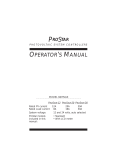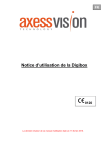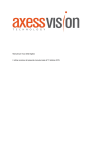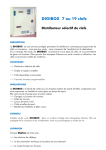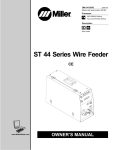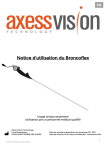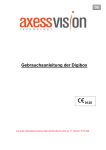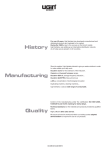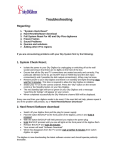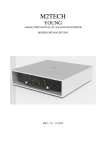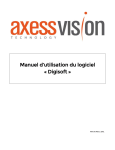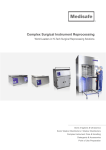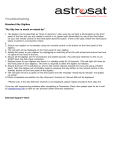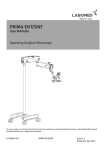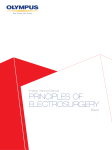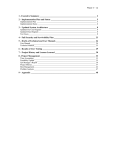Download Notice Digibox - GB - 20150225
Transcript
EN Digibox user manual 0120 The latest revision of this user’s manual dates from 11 February 2015 Contents 1 Labels and symbols ................................................................................................................... 1 1.1 Label on the Digibox_______________________________________________________________________________________________1 1.2 Connector identification symbols on the rear face of The Digibox __________________________________________________________1 1.3 Connector identification symbols on the front panel of The Digibox ________________________________________________________2 2 Safety warnings and/or Precautions to be taken ....................................................................... 2 3 Important information to be read before use ............................................................................ 2 3.1 Application fields _________________________________________________________________________________________________2 3.2 User Manual _____________________________________________________________________________________________________2 3.3 User’s qualification________________________________________________________________________________________________3 3.4 Compatibility of instruments________________________________________________________________________________________3 3.5 Repairs and modifications __________________________________________________________________________________________3 3.6 Safety instructions ________________________________________________________________________________________________3 3.7 Contraindications _________________________________________________________________________________________________4 4 Summary of the functions of the Digibox................................................................................... 4 5 Checking the contents of the packaging .................................................................................... 4 6 Installation and Connection ...................................................................................................... 6 6.1 Precautions before use ____________________________________________________________________________________________6 6.2 General inspection ________________________________________________________________________________________________6 6.3 Check the cables: supply, video, USB, etc. _____________________________________________________________________________6 7 Description of the equipment and connection instructions......................................................... 6 7.1 “Tablet” version __________________________________________________________________________________________________6 7.1.1 7.2 Connection of the Digibox __________________________________________________________________ 6 “Screen” version __________________________________________________________________________________________________6 7.2.1 7.2.2 7.2.3 Connection of the medical video monitor ______________________________________________________ 6 Connecting the supply and switching on the Digibox _____________________________________________ 7 Connection of the consumable ______________________________________________________________ 7 8 Use of the when it is connected to a tablet ................................................................................ 7 9 Use of the Digibox when it is connected to a medical video monitor .......................................... 7 10 List of possible problems ........................................................................................................... 7 10.1 Contact for the manufacturer’s Service Department ____________________________________________________________________7 11 Transport, storage, use and disposal ......................................................................................... 8 11.1 Transport, storage and use conditions________________________________________________________________________________8 11.2 Cleaning The Digibox ______________________________________________________________________________________________8 11.3 Waste disposal ___________________________________________________________________________________________________8 12 Maintenance ............................................................................................................................ 8 12.1 Nature and frequency of maintenance and calibration___________________________________________________________________8 12.2 Return from maintenance. _________________________________________________________________________________________9 13 Technical information .............................................................................................................. 9 13.1 List and length of cable ____________________________________________________________________________________________9 13.2 Requirements in relation to essential performance _____________________________________________________________________9 13.3 Information concerning the electrical protection class ___________________________________________________________________9 13.4 Information concerning electromagnetic compatibility (EMC) ____________________________________________________________10 13.4.1 Table 201: Electromagnetic emissions _______________________________________________________ 13.4.2 Table 202: Electromagnetic immunity ________________________________________________________ 13.4.3 Table 204: Electromagnetic immunity ________________________________________________________ 13.4.4 Table 206: Recommended separation distances between portable and mobile RF communication equipment _____________________________________________________________________________________ 13.5 10 10 12 13 Attestation of conformity to the specifications required ________________________________________________________________13 14 Manufacture and distributors ................................................................................................. 13 14.1 Manufacturers details ____________________________________________________________________________________________13 APPENDIX A: Technical characteristics and performance of The Digibox ....................................... 14 APPENDIX B: List of functionalities of The Digibox ......................................................................... 15 1 LABELS AND SYMBOLS 1.1 Label on the Digibox Safety labels and symbols are placed at the places shown below. If any labels or symbols are missing please contact Axess Vision Technology. The label serves for traceability and logistics; it is also a Digibox safety label and gives a unique identification. It is temporarily represented below: The codification of the label icons is described in the table below: Symbols Meaning Manufacturer: This symbol shows the name and address of the manufacturer. Date of manufacture: This symbol shows the date of manufacture. Serial number: This symbol indicates the serial number in 9 characters/figures. Catalogue reference: The manufacturer’s catalogue reference is located immediately after the symbol. Appliance with the following electrical protection class: This symbol indicates the type of class 2 electrical protection: Appliance with upgraded insulation and no metal parts. (Class 2 equipment plugs do not necessarily have a ground pin.) Type BF applied part: Type BF electronic device complying with the IEC 60601-1 standard. Protection against electric shocks. Operating instructions Refer to the user manual Do not dispose of with domestic waste Conformity marking as per the European Medical Device Directive (93/42/EEC) together with the identification number of the notified body: SGS 0120 5V mA Also includes Directive 1999 / 5 / EC covering radio equipment and telecommunications terminal equipment. - 500 Input voltage: 5V dc; courant consumption: 500 mA Symbol attesting to protection against the effects of temporary immersion in water in accordance with IEC 60529. IPN1N2 with IPN1N2 N1 = 2 , Protection against solid foreign bodies with a diameter of 12.5 mm or more, N2 = 0 , No protection for liquid bodies. 1.2 Connector identification symbols on the rear face of The Digibox The rear face of the Digibox has 4 connectors for connecting the box to the elements of the medical 1 system. Symbols Meaning USB USB 2.0 type B connector for communication and display on the tablet Switch Jack 3.5mm: not used 5V DC – 500 mA supply connector for stand-alone use (without tablet, with display on a video screen) NTSC format video output. signal amplitude: 1V peak Video 1.3 Connector identification symbols on the front panel of The Digibox The front panel of the Digibox contains a connector marked ‘Broncoflex’ for connecting the single use consumable 2 SAFETY WARNINGS AND/OR PRECAUTIONS TO BE TAKEN “WARNING” indicates a potentially hazardous situation. Ignoring it may damage the appliance, and can cause physical injury or even death. Note: On medical equipment this safety signal is only used if there is no other safety signal corresponding to the hazard. ”NOTE” indicates information or a comment. 3 IMPORTANT INFORMATION TO BE READ BEFORE USE 3.1 Application fields The Digibox is designed to be used with sterile and single use video-consumables supplied by the manufacturer, and with a central unit that is not supplied. The central unit can be a tablet or a medical video monitor. This product is reserved exclusively for bronchoscope examinations and was developed by Axess Vision Technology. The Digibox is intended to control the single use sterile endoscope and to supply a video signal for a medical monitor or a digital signal for a tablet or a computer displaying the image. For more information on the “Broncoflex®”consumable, refer to its user manual The Digibox should not be used for any other purpose. 3.2 User Manual This user manual contains key information for the optimum use of Digibox in complete safety. Read this manual and the manuals of the other instruments used, and use them accordingly. Keep all user manuals in a safe place with easy access. If you have a question or comment about this manual, don’t hesitate to contact the manufacturer. This manual describes the recommended inspection and preparation procedures prior to using the equipment, as well as those concerning its cleaning and maintenance after use. It does not describe how to carry out a given procedure, nor does it set out to teach a beginner the correct technique or medical aspects concerning the equipment's use. 2 It is up to each medical establishment to make sure that only staff who are fully trained in the theoretical and practical aspects, competent and instructed in how to use endoscopic equipment, antimicrobial agents/processes and the hospital protocol for controlling infections are involved in the sterilisation or otherwise of these medical devices. The known risks and/or potential injuries associated with flexible endoscopic procedures are primarily as follows: perforation, infection and haemorrhage. Follow all the instructions in this user manual carefully. Poor understanding of these instructions could cause: - serious injury or even death in the patient - serious injuries in the user - serious injuries in a third party - damage to the equipment. 3.3 User’s qualification If there are official standards concerning the user's qualification for carrying out bronchoscopy and endoscopic treatments, which have been defined by the “medical administration or other official institutions such as the society of endoscopy”, they must be complied with. If there are no such standards, this instrument must only be used by a physician who has been accredited by the head of the hospital's accident prevention department or head of the corresponding department (internal medicine, etc.). The physician must be capable of carrying out the planned video endoscopy and endoscopic treatments in complete safety, in line with the directives set by the society of endoscopy, etc., with account taken of the risks of complications associated with endoscopy and endoscopic treatment. This user manual does not provide any explanations or information about endoscopic techniques in themselves. 3.4 Compatibility of instruments This appliance complies with the specifications of the electromagnetic compatibility standard covering medical electrical appliances, (IEC 60601-1-2: 2001). It is strictly forbidden to use powered endotherapy accessories (including type BF and CF) with the consumable. The use of non-compatible instruments may cause injury to the patient and interfere with the operation of the video-bronchoscopy system. 3.5 Repairs and modifications The Digibox does not contain any parts that can be repaired by the user. It must not be dismantled, modified or repaired by the user as this could cause injury to the patient or the user and/or affect the operation of the videobronchoscopy system. If the instructions in this manual do not enable you to remedy the problem encountered, you should return the Digibox to the manufacturer for diagnosis and repair or replacement. 3.6 Safety instructions No. Instructions 1 For your protection against risk, observe the warnings and cautions below when handling the Digibox. You should also observe the warnings and cautions in each chapter of this user manual. 2 Observe the following precautions without fail. Failure to do so puts the patient and the medical personnel at risk of electrocution. 3 Don’t place the Digibox close to a window. Exposure to rain, water, moisture or constant direct sunlight can damage the appliance seriously. 4 Don’t place anything on the signal cable between the box and the medical video signal monitor. The cable should be placed in an area where it will not be trodden on. 5 Don’t apply excessive pressure to the front panel of The Digibox. You could damage it permanently. 6 Don’t apply excessive force to The Digibox and/or other instruments connected to it. This could damage the system and/or cause faults. 7 The Digibox does not contain any parts that can be repaired by the user. Entrust all maintenance and repairs to personnel qualified for the maintenance of the product. 3 8 If a cable or wire is damaged or stripped replace it immediately with another of the same type and size supplied by the manufacturer. The approvals and regulations apply to cables supplied by the manufacturer. 9 If the Digibox is exposed to liquids (in a way contrary to the cleaning instructions), or falls, or if its box is damaged there is a risk of electrocution or fire. Cut off the power supply to the Digibox immediately and request the help of a technician from the manufacturer. 10 Only use cables and accessories supplied by the manufacturer of the Digibox. 11 Use a cloth soaked in liquid detergent to clean the Digibox limiting your action to the outside surface of the box. Don’t submerge the Digibox in liquid; This causes safety risks when in use. 12 Don’t use the Digibox in the presence of flammable anaesthetic products. 13 Don’t use pointed or hard objects to press the buttons on the front panel and/or the keyboard keys. This can damage the buttons. 14 Don’t touch the electrical contacts in the Digibox electrical connector. 15 Don’t use the Digibox in a room exposed to strong electromagnetic radiation (e.g. close to medical equipment using microwaves or short waves, MRI, a radio or mobile phone). This could diminish the performance of the product. In cases of interference, attenuation measures such as turning or repositioning the instrument or insulating the location may be necessary. 16 We do not advise using the Digibox in the proximity of other appliances or stacking it on other appliances. If adjacent installation or stacking is necessary, check that the Digibox is working properly in its intended configuration. 17 Don’t touch the patient at the same time as the parts of the Digibox interface (except for the insulated parts of the endoscope). 3.7 Contraindications No. Instructions 1 Only use appliances listed in §0 ", for bronchoscopic observation or treatment. Other combinations of instruments can neutralise electrical insulation and seriously affect the cardiac functions of the patient and of the user/doctor. 2 Follow the precautionary measures described in the previous sections. Failure to do so exposes the patient and the medical personnel to risks of electrocution. 3 Don’t use this equipment for cardiac applications. 4 SUMMARY OF THE FUNCTIONS OF THE DIGIBOX The Digibox is an interface box between the consumable and the tablet or medical video monitor. In this user manual, the term “Digibox” always refers to the electronic interface box. 5 CHECKING THE CONTENTS OF THE PACKAGING This chapter describes the components in the parcel delivered. It may be used as a checklist when unpacking. Contact the manufacturer if any item is missing. For a description of the characteristics of the 4 appliance refer to the appropriate section in §7. Compare the contents of the packaging with the elements shown below. Check that all the accessories and components in the contents list are present and in good condition. If a part of his damaged; if an item is missing or if you have any questions, contact the manufacturer directly and don’t use the part in question No. 1 2 Description of the elements Images Digibox interface box USB 2.0 type A-B cable for connecting the Digibox interface box to the tablet (2 m) 3 Medical supply 4 Mains lead 5 RCA/RCA video cable 6 BNC-RCA adapter 7 Digibox V2 user manual Before using the AXESS VISION TECHNOLOGY video endoscope system check that the other applied parts of other medical appliances used with the configuration applicable to endoscopy appliances are type BF or CF applied parts. 5 6 INSTALLATION AND CONNECTION 6.1 Precautions before use Before use, prepare the system thoroughly. Failure to do this may cause risks of damaging the system, injuring the patient and/or, causing a fire. Check the Digibox before every use as explained below. Also check the accessories that will be used with the Digibox in accordance with their respective user manuals. Only use accessories supplied by the manufacturer. If you see anything wrong, don’t use the Digibox. If the instructions in the chapter don’t enable you to correct the fault, contact the manufacturer. Any material or other damage can put the patient or the user in danger, and seriously damage the endoscope system. Make an inspection as described below. Always consult the specific user manual for the product in question. Only use accessories supplied by the manufacturer, including supply components to prevent risks of electrical danger. 6.2 General inspection No damage should be visible on the product (e.g., the deformation or cracks). The product should be clean. The product should not carry any residues of cleaning or disinfectant products. Make sure that no parts are missing and that all components are properly fixed. Make sure that the connection elements between the instruments are in good working order. Check that all the components of an instrument, system are correctly assembled and fixed. Before every use of the ENDOSCOPE check that the orientation of the images observed is correct. 6.3 Check the cables: supply, video, USB, etc. Check that the cable is not broken. Check for faulty insulation. Check that the connectors are intact and carry no traces of corrosion. Any instrument found faulty on unpacking should be returned in its original box. If this is not possible, pack each component separately in a sufficient quantity of paper or foam and place it in a box. Product returns must have prior authorisation from the manufacturer will indicate the procedure to be followed. The Service Department will not accept warranty claims in the event of damage due to inadequate packing. 7 DESCRIPTION OF THE EQUIPMENT AND CONNECTION INSTRUCTIONS 7.1 “Tablet” version 7.1.1 Connection of the Digibox When using the Digibox with a tablet, connect the type B USB connector to the socket marked “USB” on the rear face of the Digibox and the type A connector to the tablet. The USB 2.0 type A-B cable connecting the tablet to the Digibox serves for the power supply to The Digibox and the transmission of the data flow for the images displayed on the tablet. It is not necessary to connect the medical supply provided. 7.2 “Screen” version 7.2.1 Connection of the medical video monitor Images from the Broncoflex® can be viewed on a medical video monitor accepting the NTSC standard, via a composite video input. Refer to the installation and user manual of the medical monitor used to connect the cable and select the appropriate input. Connect one end of the cable to the RCA connector of the Digibox (marked ‘Video’) and the other end to the composite video input of the screen. 6 7.2.2 Connecting the supply and switching on the Digibox Connect the medical supply cable to the Digibox connector, the female connector of the mains cable to the medical supply and the male connector to a wall socket. If no consummable is connected to the Digibox, it automatically switches to the standby mode (low consumption). To switch off the Digibox, disconnect the medical supply from the mains. If an extension block is used to supply power to the Digibox: - check that it complies with the IEC 60884-1 standard - make sure that it is not placed on the floor, to prevent penetration by fluids or mechanical damage 7.2.3 Connection of the consumable Connect the single use consumable to the connector on the front panel of the Digibox, marked ‘Broncoflex’. 8 USE OF THE WHEN IT IS CONNECTED TO A TABLET When the Digibox is connected to a tablet it is essential to use the software sold by Axess Vision Technology to control it. Refer to the user manual supplied with the software. 9 USE OF THE DIGIBOX WHEN IT IS CONNECTED TO A MEDICAL VIDEO MONITOR The Digibox LED on the front panel of The Digibox indicates the state of the The Digibox and/or of the consumable. LED off When the power supply to The Digibox is cut off, the LED on the front panel is off: Blue LED When power to The Digibox is on, the LED on the front panel is blue (Standby mode) Green LED If a new consumable is connected to The Digibox, the LED lights up green and the image from the video is displayed on the medical video monitor Red LED If a consumable that has already been used is connected to the Digibox, the RED LED flashes and the medical video monitor displays a black image. It is possible to reuse the consumable by pressing the small button on the left of the LED. If a colour fault is observed on the image, pressing the small red button on the left of the LED triggers automatic adjustment of the white balance to obtain a better rendering of the colours in the image. This should be done once a white “reference” has been put in front of the camera (a white sheet or other) without touching the endoscope with it or you could create cross contamination. After pressing the small white balance button the white sheet should be held in front of the camera as long as the white LED is active, and then switch to green when the white balance is completed. The consumable is for single use only. Its reuse is under the user’s responsibility. 10 LIST OF POSSIBLE PROBLEMS 10.1 Contact for the manufacturer’s Service Department For each of the following items, checking procedures and actions are proposed. They enable most problems encountered to be solved, and limit calls to the manufacturer technician Nevertheless, for any problem not solved, contact the maintenance Department at AXESS VISION TECHNOLOGY. Axess Vision TECHNOLOGY 7 3 rue Robespierre - 37700 SAINT PIERRE DES CORPS – Fr Tel.: +33 (0)2 47 34 32 00 Fax: +33 (0)2 47 34 32 99 Problems Causes Actions Poor endoscope/digital box connection Solution 1: First check that the consumable has been detected (LED on GREEN or flashing RED). Disconnect and reconnect the consumable If the fault persists go to solution 2. No image or image without colour Solution 2: Collect and another consumable Faulty consumable 11 If the fault persists, Department (see §14.1). contact the manufacture’s Service TRANSPORT, STORAGE, USE AND DISPOSAL 11.1 Transport, storage and use conditions Transport and storage conditions Settings Minimum Maximum Temperature 0 °C (32 °F) + 70 °C (158 °F) 10% 90% + 10 °C (50 °F) + 40 °C (104 °F) 30% 85% Relative humidity of the air (without, condensation) Temperature Conditions of use Relative humidity of the air (without, condensation) The Digibox has a protection index of IP20. Type of protection It should be stored sheltered from projections of foreign bodies with a diameter of 12.5mm or more. It is essential that it is stored sheltered from liquid projections because there is no protection against water drops. 11.2 Cleaning The Digibox Use wipes with alcohol solutions or a nonabrasive cloth soaked in the liquid detergent commonly used in hospitals. 11.3 Waste disposal In accordance with Directive 2002/96/EC covering waste electrical and electronic equipment (WEEE), The Digibox falls into category 8 of the WEEE (Medical devices, except for implanted and infected products). To preserve the environment it is essential not to dispose of the Digibox electronic interface box with domestic waste, but to dispose of it with electrical and electronic equipment via a process of reuse, recycling or another form of reclamation of this electrical and electronic equipment. If necessary, return the Digibox to Axess Vision Technology, who will handle its disposal (the address for returns is given in §14.1). 12 MAINTENANCE 12.1 Nature and frequency of maintenance and calibration The maintenance frequency is 12 months. This preventive maintenance can only be performed by personnel qualified by the manufacturer. No recalibration is required. 8 No. Description the elements of Images Cable length 1 USB 2.0 A-B CABLE, MALE BLACK 2M 2m 2 Medical supply 3m 3 Digibox supply cable 2m 4 RCA – RCA video cable 2m 5 Female BNCfemale RCA adapter -- Manufacturer & reference Type Cable connecting the tablet to the Digibox Qualtek USB 2.0 certified type A male-B male Ref.: 3021007-06 Universal 5V - 15W medical supply (240V) SL POWER and AULT Supply cable EEC 777 - IEC 320-C13 Coaxial For connecting the RCARCA to a medical video monitor Ref.: MENB1020A0503F01 CNC Tech Ref.: 800-0.75-14X-BL00200 Pro Signal Ref.: AV02595 MULTICOMP Ref.: 25-7510 12.2 Return from maintenance. It is recommended that the user check operation before putting the appliance back into service. 13 TECHNICAL INFORMATION 13.1 List and length of cable The Digibox only operates with cables supplied by the manufacturer 13.2 Requirements in relation to essential performance The following requirements are checked and validated. No. Requirements in relation to essential performance 1 Check the orientation of the images in the view observed by the operator 2 Make sure that there is no unacceptable risk, in the event of a fault, or specific error, of the supply of a particular power or spectral frequency, necessary for a specific diagnosis or therapy, which is not identifiable by a trained operator 3 Make sure that the operator observes the active image rather than a saved image during an endoscope procedure. 13.3 Information concerning the electrical protection class The symbol on the Digibox label shows the electrical protection class type. The Digibox is class 2, and satisfies the following requirements: • Protection provided by a combination structural arrangements making it unlikely that the 9 appliance ground will become live. • Addition of extra “insulation” to the main insulation. • Metal parts separated from live parts by the main insulation that is not accessible to the user. • No possibility of grounding the chassis (elimination of risks of contact potential). 13.4 Information concerning electromagnetic compatibility (EMC) The Digibox is designed to be used in an electromagnetic environment as specified below. The Digibox satisfies the EN 60601-1-2:2007 standard. 13.4.1 Table 201: Electromagnetic emissions Recommendations and declaration of the manufacturer – electromagnetic emission The Digibox is designed to be used in the electromagnetic environment specified below. The customer or user of the Digibox must ensure that it is used in such an environment. Emissions test Compliance Electromagnetic environment Recommendations Group 1 The Digibox uses RF energy only for its internal operation. Consequently, its emissions are very low and not likely to cause interference with neighbouring electronic equipment. RF emissions CISPR 11 RF emissions CISPR 11 Class B Harmonic emissions IEC 61000-3-2 Not applicable Voltage fluctuations/Flicker The Digibox is suitable for use in all premises, including domestic premises and those directly linked to a low voltage public electricity supply feeding buildings in domestic use Not applicable IEC 61000-3-3 13.4.2 Table 202: Electromagnetic immunity Recommendations and manufacturer’s declaration – electromagnetic immunity The Digibox is designed to be used in the electromagnetic environment specified below. The customer or user of the Digibox must ensure that it is in such an environment. IMMUNITY test Test level IEC 60601 Level of conformity Electromagnetic environment – directives Electrostatic discharge (EDS) IEC 61000-4-2 6 kV on contact 8 kV in the air 6 kV on contact 8 kV in the air Floors should be made of wood, concrete or ceramic tiles. If floors are covered with synthetic material, the relative humidity should be at least 30% Fast transient burst surge IEC 61000-4-4 2 kV for electricity supply lines 2 kV for electricity supply lines 1 kV or input/output lines 1 kV or input/output lines The quality of the electricity supply circuit should be that of a typical commercial or hospital environment. 10 Transient overvoltage IEC 61000-4-5 Voltage dip, short interruptions and voltage variations on the electricity supply input lines IEC 61000-4-11 Magnetic field at the electricity mains frequency (50/60 Hz) IEC 61000-4-8 1 kV between phases 2 kV between phases and ground 1 kV between phases Not applicable (class 2) <5% UT (>95 % dips of UT) during 0.5 cycle <5 % UT (>95 % dips of UT) during 0.5 cycle 40 % UT (60 % dip of UT) During 5 cycles 40 % UT (60 % dip of UT) during 5 cycles 70 % UT (>30 % dips of UT) during 25 cycles 70 % UT (>30 % dips of UT) during 25 cycles <5% UT (>95 % dip of UT) for 5 s <5% UT (>95 % dips of UT) for 5 s 3 A/m 3 A/m The quality of the electricity supply circuit should be that of a typical commercial or hospital environment. The quality of the electricity supply circuit should be that of a typical commercial or hospital environment. If The Digibox user requires continuous operation during power cuts, we recommend feeding The Digibox from an uninterruptible power supply or a battery. The magnetic fields at mains frequency should have the characteristic levels of a representative place situated in a typical commercial or hospital environment. NOTE: UT is the AC mains voltage before application of the test level. 11 13.4.3 Table 204: Electromagnetic immunity Recommendations and manufacturer’s declaration – electromagnetic immunity The Digibox is designed to be used in the electromagnetic environment specified below. The customer or user of the Digibox must ensure that it is in such an environment. Immunity test Test level, according to IEC 60601 Complianc e level Electromagnetic environment directives Portable and mobile RF communication equipment should not be used nearer to any part of the equipment (including cables) than the recommended separation distance, calculated using the equation below on the basis of the frequency of the transmitter. Conducted RF interference IEC 61000-4-6 3 Veff 150 kHz to 80 MHz Radiated RF interference IEC 61000-4-3 80 MHz to 2.5 GHz 3 Veff Recommended separation distance 3 V/m 80 MHz to 800 MHz 3 V/m 800 MHz to 2.5 GHz where P is the maximum output power characteristic of the transmitter in watts (W), according to the transmitter manufacturer and is the recommended separation distance in metres (m). The field strength of fixed RF transmitters, as determined by an electromagnetic survey on site (a), should be less than the compliance level at each frequency range (b). Interference can arise close to an appliance carrying the following symbol: - NOTE 1 At 80 MHz, and at 800 MHz, the eyes frequency range applies. - NOTE 2 These directives cannot apply in all situations. Electromagnetic propagation is affected by the absorption and reflection of structures, objects and persons. (a) It is not possible to predict theoretically the exact field strength of fixed transmitters, such as radio telephone base stations (cell phones/wireless phones) and land mobile radios, amateur radios, AM and FM radio receivers and television. To evaluate the electromagnetic environment created by fixed RF transmitters, an electronic survey on site should be envisaged. If the field strength measured at the point of use of this device exceeds the RF compliance level above , the operation of the device should be checked. If problems are observed, other measures may be necessary, such as turning or moving The Digibox. (b) In the frequency range from 150 kHz to 80 MHz, the field strength should be less than 3 V/m. 12 13.4.4 Table 206: Recommended separation distances between portable and mobile RF communication equipment Separation distances recommended between portable and mobile RF communication equipment and La Digibox The Digibox is designed to be used in an electromagnetic environment in which the radio electric interference radiation is controlled. The customer or user of the Digibox can contribute to preventing electromagnetic interference by maintaining a minimum distance between the portable and mobile RF communications equipment (transmitters) and the Digibox, as recommended below, depending on the maximum transmission power of the communication equipment. Separation distance, according to the transmitter frequency (m) Maximum assigned output power of the transmitter (calculated with V2= 3 V and E1 = 3 V/m) 150 kHz to 80 MHz 80 MHz to 800 MHz 800 MHz to 2.5 GHz W • - 0.01 - 0.12 - 0.12 - 0.23 - 0.1 - 0.38 - 0.38 - 0.73 -1 1.2 1.2 2.3 10 3.8 3.8 7.3 100 12 12 23 This guide does not apply to all environments. Electromagnetic propagation depends on the absorption and reflection properties of floors, objects and persons. Portable and mobile RF communication equipment such as cell phones should not be used nearer to the equipment (including cables) than the recommended separation distance, calculated using the equation below on the basis of the frequency of the transmitter. 13.5 Attestation of conformity to the specifications required The manufacturer, AXESS VISION TECHNOLOGY, attests to the compliance of his equipment, both from the points of view of design and of manufacture according to the directives and regulations in force. He uses appropriate components, taking into account: • Their technical characteristics and their limitations, • the intended use and the electromagnetic environment . 14 MANUFACTURE AND DISTRIBUTORS 14.1 Manufacturers details AXESS VISION TECHNOLOGY 3 rue Robespierre 37700 Saint-Pierre-des-Corps France Tel.: +33 (0)2 47 34 32 90 Fax: +33 (0)2 47 34 32 99 Email: [email protected] 13 APPENDIX A: T ECHNICAL CHARACTERISTICS AND PERFORMANCE OF T HE D IGIBOX Description Type ELECTRICAL CHARACTERISTICS AC/DC adapter, external mains Supply Type of electrocution protection Fluctuation 100-240V; 0.5 A Frequency 50- 60 Hz Class 2 MECHANICAL CHARACTERISTICS Dimensions (Digibox case) (L: 145mm) x (H: 32mm) x (P: 103mm) Weight (Digibox unit) 0.6 Kg MISCELLANEOUS CHARACTERISTICS Protection index IP 20 Video standard (analogue) NTSC on RCA output Video output RCA USB interface Type A (USB 2.0) & Type B Video format (digital) MPEG / H264 Accessories supplied with The Digibox USB cable & RCA / RCA video cable 14 APPENDIX B: L I ST OF FUNCTIONALITIE S OF T HE D IGIBOX No. BRIEF DESCRIPTION 1 Real time video display 2 Detection of the re-use of a single use sterile endoscope 3 USB 2.0 interface enabling viewing and saving of the video on a tablet 15 Copyright @2015 SA AXESS VISION TECHNOLOGY: All rights reserved. Any reproduction - even partial - of the page by any means whatsoever (electronic, photocopy, printer, magnetic tape, disk, CD-Rom or other) is prohibited without prior written permission from SA AXESS VISION TECHNOLOGY. ([email protected])



















